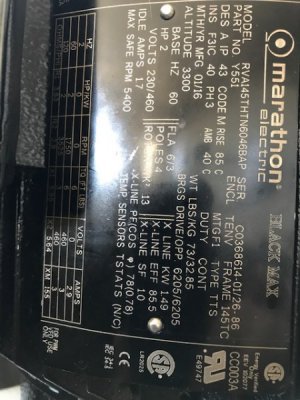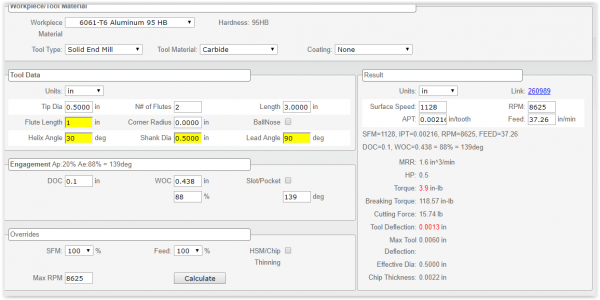I have a PM-932 converted to CNC with the spindle driven by a 2HP 3Ph Marathon Black Max motor and a Hitachi WJ200 VFD. My question is are my VFD settings correct for constant torque at low rpm? I'm asking because I was milling 6061 with a new 2 flute 1/2" carbide end mill at 5000 rpm, .100" DOC, .438 WOC, and the motor bogged down and snapped the end mill. I thought my settings were relatively conservative. My thinking is I've overlooked a VFD parameter setting somewhere. Any help given is appreciated.
My pulley ratio is 2.5:1 which gives me a rpm range from 345 to 1380 in the low range and 2156 to 8625 in high. I've attached a photo of my motor data plate for info. If you need more info let me know and I will dig it up and post it.
Here are my current settings for the torque related parameters -
A041 - Torque Boost Select
01 Automatic torque boost)
Automatic torque boost)
A042 - Manual Torque Boost Value
1%
A043 - Manual Torque Boost Frequency
5%
A044 - V/f characteristic curve
03 Sensorless vector (SLV))
Sensorless vector (SLV))
B040 -
Torque limit selection
00 Quadrant-specific setting mode)
Quadrant-specific setting mode)
B041 -
Torque limit 1 (fwd/power)
200%
B042 -
Torque limit 2 (rev/regen.)
200%
B043 -
Torque limit 3 (rev/power)
200%
B044 -
Torque limit 4 (fwd/regen.)
200%
B045 -
Torque LAD STOP selection
00 Disable)
Disable)
C054 -
Over-torque/under-torque selection
00 Over-torque)
Over-torque)
C055 - Over/under-torque level(Forward powering mode)
100%
C056 - Over/under-torque level(Reverse regen. mode)
100%
C057 - Over/under-torque level(Reverse powering mode)
100%
C058 - Over/under-torque level(Forward regen. mode)
100%
C059 - Signal output mode of Over/under-torque
01 During constant speed only)
During constant speed only)

My pulley ratio is 2.5:1 which gives me a rpm range from 345 to 1380 in the low range and 2156 to 8625 in high. I've attached a photo of my motor data plate for info. If you need more info let me know and I will dig it up and post it.
Here are my current settings for the torque related parameters -
A041 - Torque Boost Select
01
A042 - Manual Torque Boost Value
1%
A043 - Manual Torque Boost Frequency
5%
A044 - V/f characteristic curve
03
B040 -
Torque limit selection
00
B041 -
Torque limit 1 (fwd/power)
200%
B042 -
Torque limit 2 (rev/regen.)
200%
B043 -
Torque limit 3 (rev/power)
200%
B044 -
Torque limit 4 (fwd/regen.)
200%
B045 -
Torque LAD STOP selection
00
C054 -
Over-torque/under-torque selection
00
C055 - Over/under-torque level(Forward powering mode)
100%
C056 - Over/under-torque level(Reverse regen. mode)
100%
C057 - Over/under-torque level(Reverse powering mode)
100%
C058 - Over/under-torque level(Forward regen. mode)
100%
C059 - Signal output mode of Over/under-torque
01



